Community Health Promotion Program: Diabetes Management in Canada
VerifiedAdded on 2022/09/02
|19
|4570
|29
Report
AI Summary
This report details the development of a community health promotion program designed to address the high prevalence of Type 2 Diabetes Mellitus (T2DM) within the First Nations population of Alberta, Canada. The program, structured around a Program Logic Model, aims to improve assessment and long-term management of T2DM. It identifies the target population, the First Nations aged 18+, and highlights the priority community diagnosis: the high prevalence and risk of T2DM due to environmental risk factors, including limited access to education, employment, and culturally appropriate healthcare. The program outline includes identified needs (educational, service, dietary, and employment), goals (improving awareness, detection, treatment, and management), and measurable outputs such as community workshops, diabetes counseling, and advocacy for increased funding and culturally competent services. Expected outcomes encompass increased health literacy, improved dietary and lifestyle habits, and reduced diabetes risk. The report also discusses available resources, health promotion strengths and limitations, and the role of Community Health Nurses in program implementation, emphasizing assessment, education, and collaboration within a multidisciplinary team. The program seeks to address the environmental risk factors which impact the First Nations population.
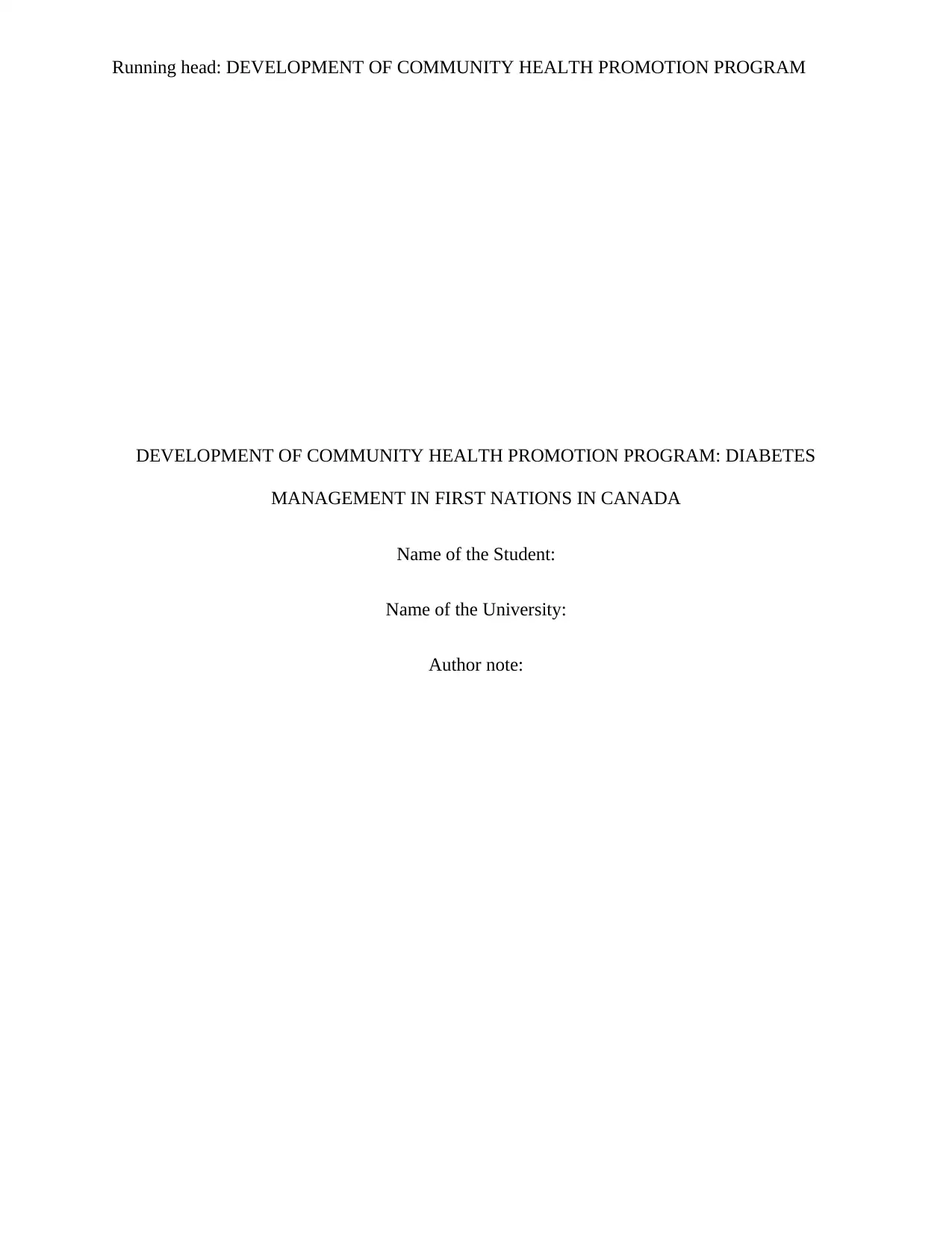
Running head: DEVELOPMENT OF COMMUNITY HEALTH PROMOTION PROGRAM
DEVELOPMENT OF COMMUNITY HEALTH PROMOTION PROGRAM: DIABETES
MANAGEMENT IN FIRST NATIONS IN CANADA
Name of the Student:
Name of the University:
Author note:
DEVELOPMENT OF COMMUNITY HEALTH PROMOTION PROGRAM: DIABETES
MANAGEMENT IN FIRST NATIONS IN CANADA
Name of the Student:
Name of the University:
Author note:
Paraphrase This Document
Need a fresh take? Get an instant paraphrase of this document with our AI Paraphraser

1DEVELOPMENT OF COMMUNITY HEALTH PROMOTION PROGRAM
Introduction
Purpose and Strategy
The purpose of the following paper is to outline an effective community health promotion
program for the First Nations of Canada, with respect to improved assessment and long term
management of metabolic conditions such as type 2 diabetes mellitus (T2DM). To address the
same, the community health promotion program and relevant strategies outlined in this paper
will be based upon a course of the ‘Program Logic Model’.
Description of Target Population
The target population will comprise of individuals, aged 18 years and above and
belonging to the First Nations population groups in Alberta. The rationale underlying this
selection is the reported high prevalence of 15.3% of T2DM in this groups and highest
prevalence of 19.1% T2DM in Alberta as compared to other regions of Canada (Public Canada,
2020).
Priority Community Diagnosis
The priority community diagnosis is the high prevalence and risk of T2DM in First
Nations due to environmental risk factors. Environmental risk factors are associated with
hindrances to the access of adequate levels of income, employment, education and culturally
appropriate healthcare resources and services as a result of the disparities encountered by First
Nations due to their history of discrimination and remote location (Beckett, Firestone, McKnight,
Smylie & Rotondi, 2018).
Introduction
Purpose and Strategy
The purpose of the following paper is to outline an effective community health promotion
program for the First Nations of Canada, with respect to improved assessment and long term
management of metabolic conditions such as type 2 diabetes mellitus (T2DM). To address the
same, the community health promotion program and relevant strategies outlined in this paper
will be based upon a course of the ‘Program Logic Model’.
Description of Target Population
The target population will comprise of individuals, aged 18 years and above and
belonging to the First Nations population groups in Alberta. The rationale underlying this
selection is the reported high prevalence of 15.3% of T2DM in this groups and highest
prevalence of 19.1% T2DM in Alberta as compared to other regions of Canada (Public Canada,
2020).
Priority Community Diagnosis
The priority community diagnosis is the high prevalence and risk of T2DM in First
Nations due to environmental risk factors. Environmental risk factors are associated with
hindrances to the access of adequate levels of income, employment, education and culturally
appropriate healthcare resources and services as a result of the disparities encountered by First
Nations due to their history of discrimination and remote location (Beckett, Firestone, McKnight,
Smylie & Rotondi, 2018).
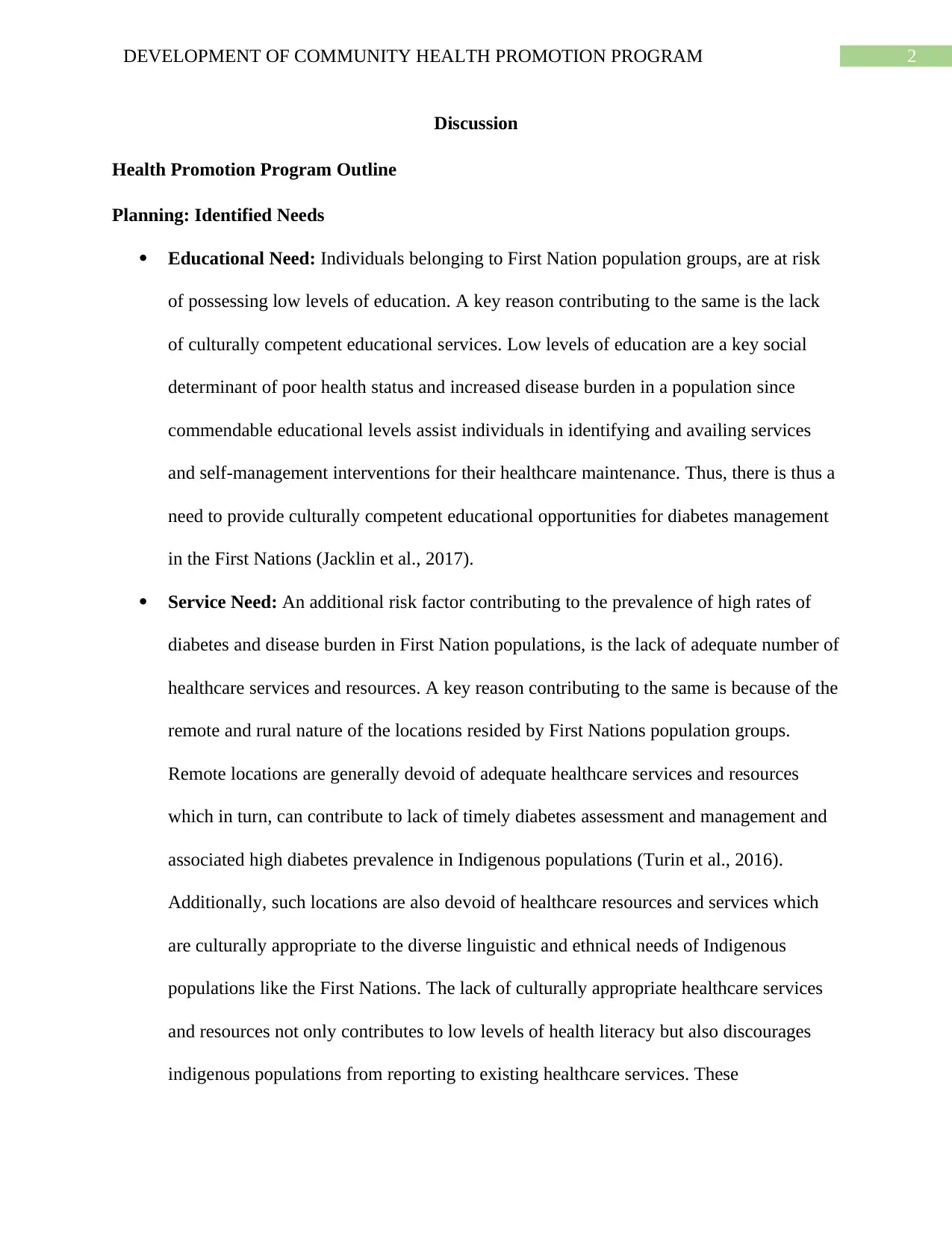
2DEVELOPMENT OF COMMUNITY HEALTH PROMOTION PROGRAM
Discussion
Health Promotion Program Outline
Planning: Identified Needs
Educational Need: Individuals belonging to First Nation population groups, are at risk
of possessing low levels of education. A key reason contributing to the same is the lack
of culturally competent educational services. Low levels of education are a key social
determinant of poor health status and increased disease burden in a population since
commendable educational levels assist individuals in identifying and availing services
and self-management interventions for their healthcare maintenance. Thus, there is thus a
need to provide culturally competent educational opportunities for diabetes management
in the First Nations (Jacklin et al., 2017).
Service Need: An additional risk factor contributing to the prevalence of high rates of
diabetes and disease burden in First Nation populations, is the lack of adequate number of
healthcare services and resources. A key reason contributing to the same is because of the
remote and rural nature of the locations resided by First Nations population groups.
Remote locations are generally devoid of adequate healthcare services and resources
which in turn, can contribute to lack of timely diabetes assessment and management and
associated high diabetes prevalence in Indigenous populations (Turin et al., 2016).
Additionally, such locations are also devoid of healthcare resources and services which
are culturally appropriate to the diverse linguistic and ethnical needs of Indigenous
populations like the First Nations. The lack of culturally appropriate healthcare services
and resources not only contributes to low levels of health literacy but also discourages
indigenous populations from reporting to existing healthcare services. These
Discussion
Health Promotion Program Outline
Planning: Identified Needs
Educational Need: Individuals belonging to First Nation population groups, are at risk
of possessing low levels of education. A key reason contributing to the same is the lack
of culturally competent educational services. Low levels of education are a key social
determinant of poor health status and increased disease burden in a population since
commendable educational levels assist individuals in identifying and availing services
and self-management interventions for their healthcare maintenance. Thus, there is thus a
need to provide culturally competent educational opportunities for diabetes management
in the First Nations (Jacklin et al., 2017).
Service Need: An additional risk factor contributing to the prevalence of high rates of
diabetes and disease burden in First Nation populations, is the lack of adequate number of
healthcare services and resources. A key reason contributing to the same is because of the
remote and rural nature of the locations resided by First Nations population groups.
Remote locations are generally devoid of adequate healthcare services and resources
which in turn, can contribute to lack of timely diabetes assessment and management and
associated high diabetes prevalence in Indigenous populations (Turin et al., 2016).
Additionally, such locations are also devoid of healthcare resources and services which
are culturally appropriate to the diverse linguistic and ethnical needs of Indigenous
populations like the First Nations. The lack of culturally appropriate healthcare services
and resources not only contributes to low levels of health literacy but also discourages
indigenous populations from reporting to existing healthcare services. These
⊘ This is a preview!⊘
Do you want full access?
Subscribe today to unlock all pages.

Trusted by 1+ million students worldwide
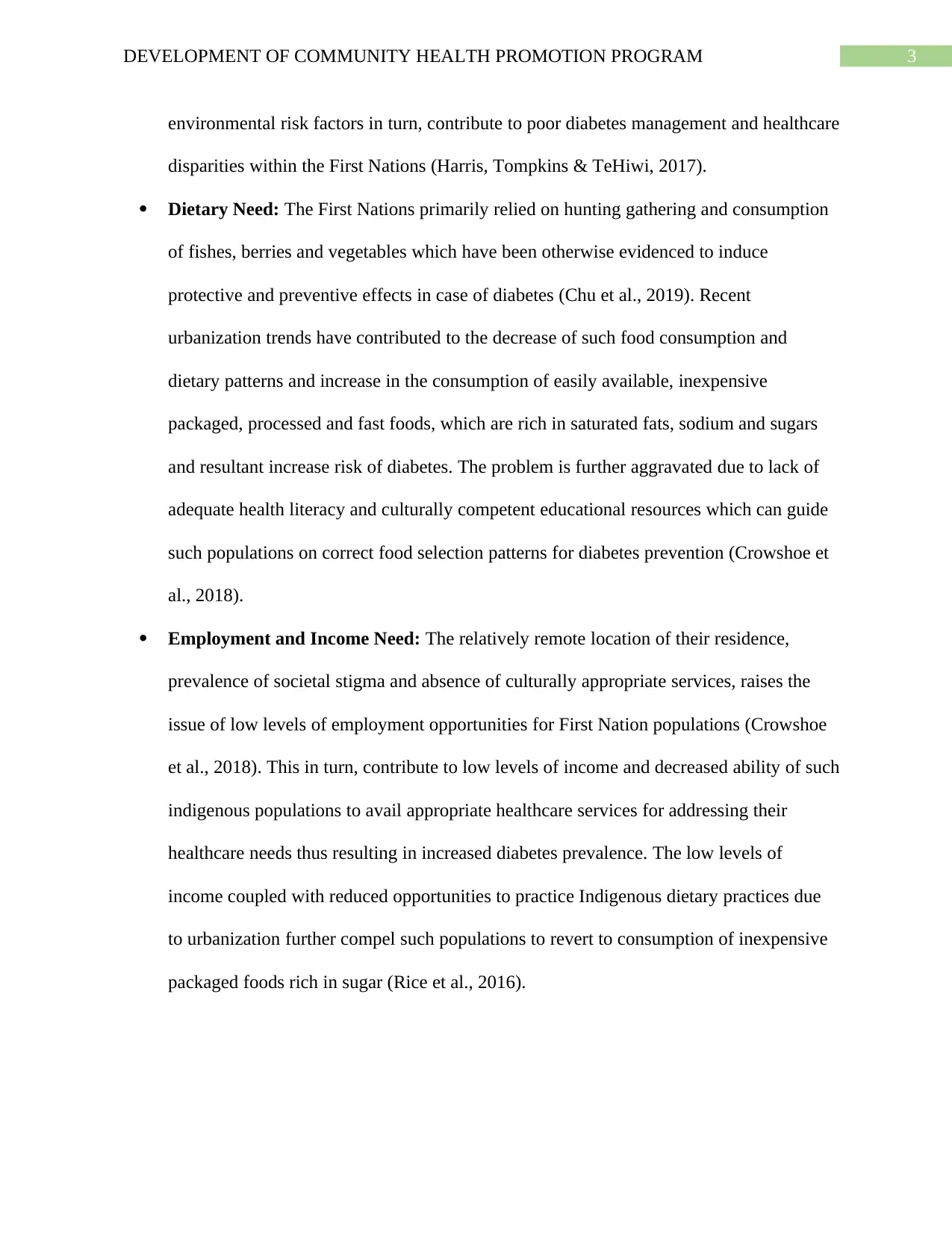
3DEVELOPMENT OF COMMUNITY HEALTH PROMOTION PROGRAM
environmental risk factors in turn, contribute to poor diabetes management and healthcare
disparities within the First Nations (Harris, Tompkins & TeHiwi, 2017).
Dietary Need: The First Nations primarily relied on hunting gathering and consumption
of fishes, berries and vegetables which have been otherwise evidenced to induce
protective and preventive effects in case of diabetes (Chu et al., 2019). Recent
urbanization trends have contributed to the decrease of such food consumption and
dietary patterns and increase in the consumption of easily available, inexpensive
packaged, processed and fast foods, which are rich in saturated fats, sodium and sugars
and resultant increase risk of diabetes. The problem is further aggravated due to lack of
adequate health literacy and culturally competent educational resources which can guide
such populations on correct food selection patterns for diabetes prevention (Crowshoe et
al., 2018).
Employment and Income Need: The relatively remote location of their residence,
prevalence of societal stigma and absence of culturally appropriate services, raises the
issue of low levels of employment opportunities for First Nation populations (Crowshoe
et al., 2018). This in turn, contribute to low levels of income and decreased ability of such
indigenous populations to avail appropriate healthcare services for addressing their
healthcare needs thus resulting in increased diabetes prevalence. The low levels of
income coupled with reduced opportunities to practice Indigenous dietary practices due
to urbanization further compel such populations to revert to consumption of inexpensive
packaged foods rich in sugar (Rice et al., 2016).
environmental risk factors in turn, contribute to poor diabetes management and healthcare
disparities within the First Nations (Harris, Tompkins & TeHiwi, 2017).
Dietary Need: The First Nations primarily relied on hunting gathering and consumption
of fishes, berries and vegetables which have been otherwise evidenced to induce
protective and preventive effects in case of diabetes (Chu et al., 2019). Recent
urbanization trends have contributed to the decrease of such food consumption and
dietary patterns and increase in the consumption of easily available, inexpensive
packaged, processed and fast foods, which are rich in saturated fats, sodium and sugars
and resultant increase risk of diabetes. The problem is further aggravated due to lack of
adequate health literacy and culturally competent educational resources which can guide
such populations on correct food selection patterns for diabetes prevention (Crowshoe et
al., 2018).
Employment and Income Need: The relatively remote location of their residence,
prevalence of societal stigma and absence of culturally appropriate services, raises the
issue of low levels of employment opportunities for First Nation populations (Crowshoe
et al., 2018). This in turn, contribute to low levels of income and decreased ability of such
indigenous populations to avail appropriate healthcare services for addressing their
healthcare needs thus resulting in increased diabetes prevalence. The low levels of
income coupled with reduced opportunities to practice Indigenous dietary practices due
to urbanization further compel such populations to revert to consumption of inexpensive
packaged foods rich in sugar (Rice et al., 2016).
Paraphrase This Document
Need a fresh take? Get an instant paraphrase of this document with our AI Paraphraser
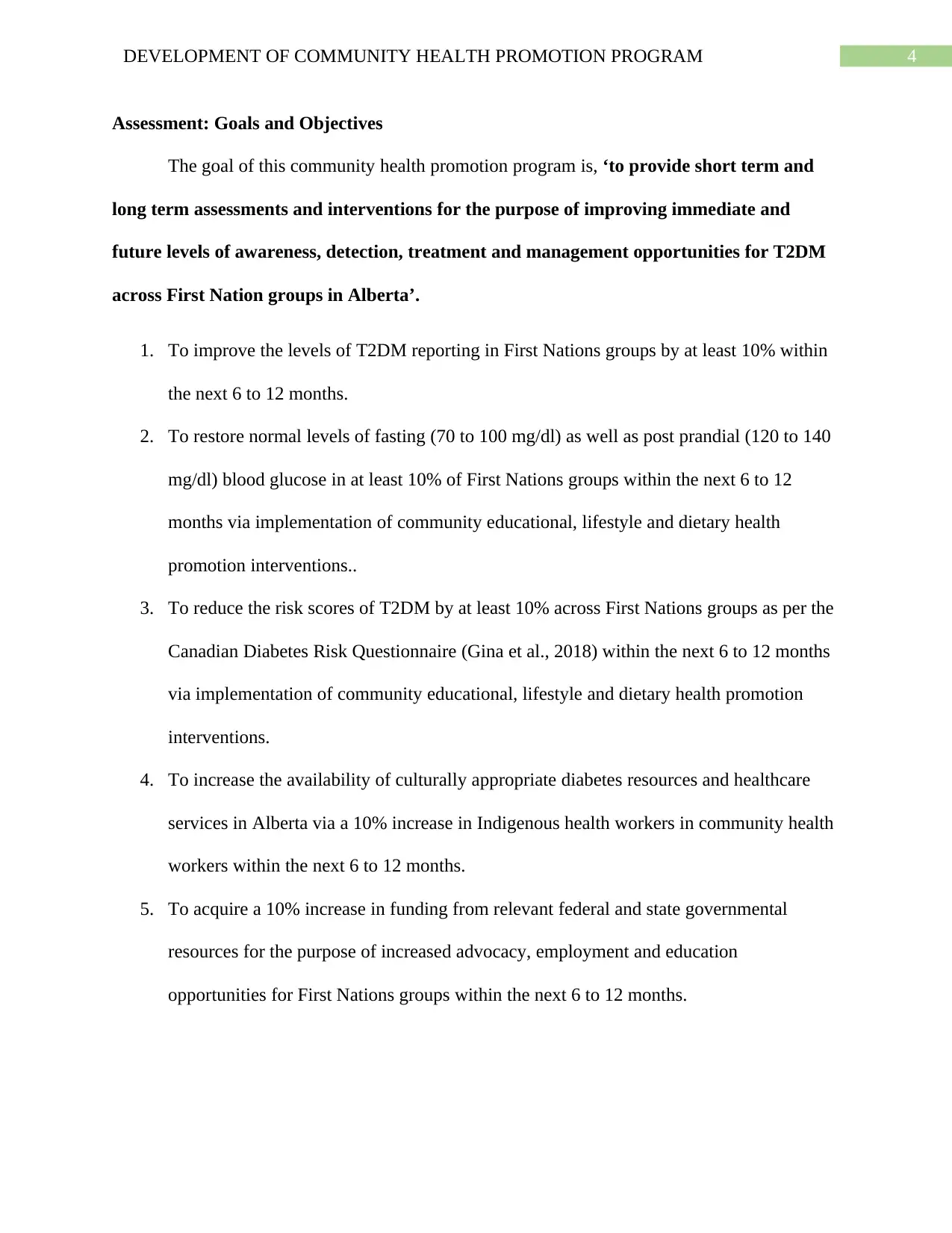
4DEVELOPMENT OF COMMUNITY HEALTH PROMOTION PROGRAM
Assessment: Goals and Objectives
The goal of this community health promotion program is, ‘to provide short term and
long term assessments and interventions for the purpose of improving immediate and
future levels of awareness, detection, treatment and management opportunities for T2DM
across First Nation groups in Alberta’.
1. To improve the levels of T2DM reporting in First Nations groups by at least 10% within
the next 6 to 12 months.
2. To restore normal levels of fasting (70 to 100 mg/dl) as well as post prandial (120 to 140
mg/dl) blood glucose in at least 10% of First Nations groups within the next 6 to 12
months via implementation of community educational, lifestyle and dietary health
promotion interventions..
3. To reduce the risk scores of T2DM by at least 10% across First Nations groups as per the
Canadian Diabetes Risk Questionnaire (Gina et al., 2018) within the next 6 to 12 months
via implementation of community educational, lifestyle and dietary health promotion
interventions.
4. To increase the availability of culturally appropriate diabetes resources and healthcare
services in Alberta via a 10% increase in Indigenous health workers in community health
workers within the next 6 to 12 months.
5. To acquire a 10% increase in funding from relevant federal and state governmental
resources for the purpose of increased advocacy, employment and education
opportunities for First Nations groups within the next 6 to 12 months.
Assessment: Goals and Objectives
The goal of this community health promotion program is, ‘to provide short term and
long term assessments and interventions for the purpose of improving immediate and
future levels of awareness, detection, treatment and management opportunities for T2DM
across First Nation groups in Alberta’.
1. To improve the levels of T2DM reporting in First Nations groups by at least 10% within
the next 6 to 12 months.
2. To restore normal levels of fasting (70 to 100 mg/dl) as well as post prandial (120 to 140
mg/dl) blood glucose in at least 10% of First Nations groups within the next 6 to 12
months via implementation of community educational, lifestyle and dietary health
promotion interventions..
3. To reduce the risk scores of T2DM by at least 10% across First Nations groups as per the
Canadian Diabetes Risk Questionnaire (Gina et al., 2018) within the next 6 to 12 months
via implementation of community educational, lifestyle and dietary health promotion
interventions.
4. To increase the availability of culturally appropriate diabetes resources and healthcare
services in Alberta via a 10% increase in Indigenous health workers in community health
workers within the next 6 to 12 months.
5. To acquire a 10% increase in funding from relevant federal and state governmental
resources for the purpose of increased advocacy, employment and education
opportunities for First Nations groups within the next 6 to 12 months.
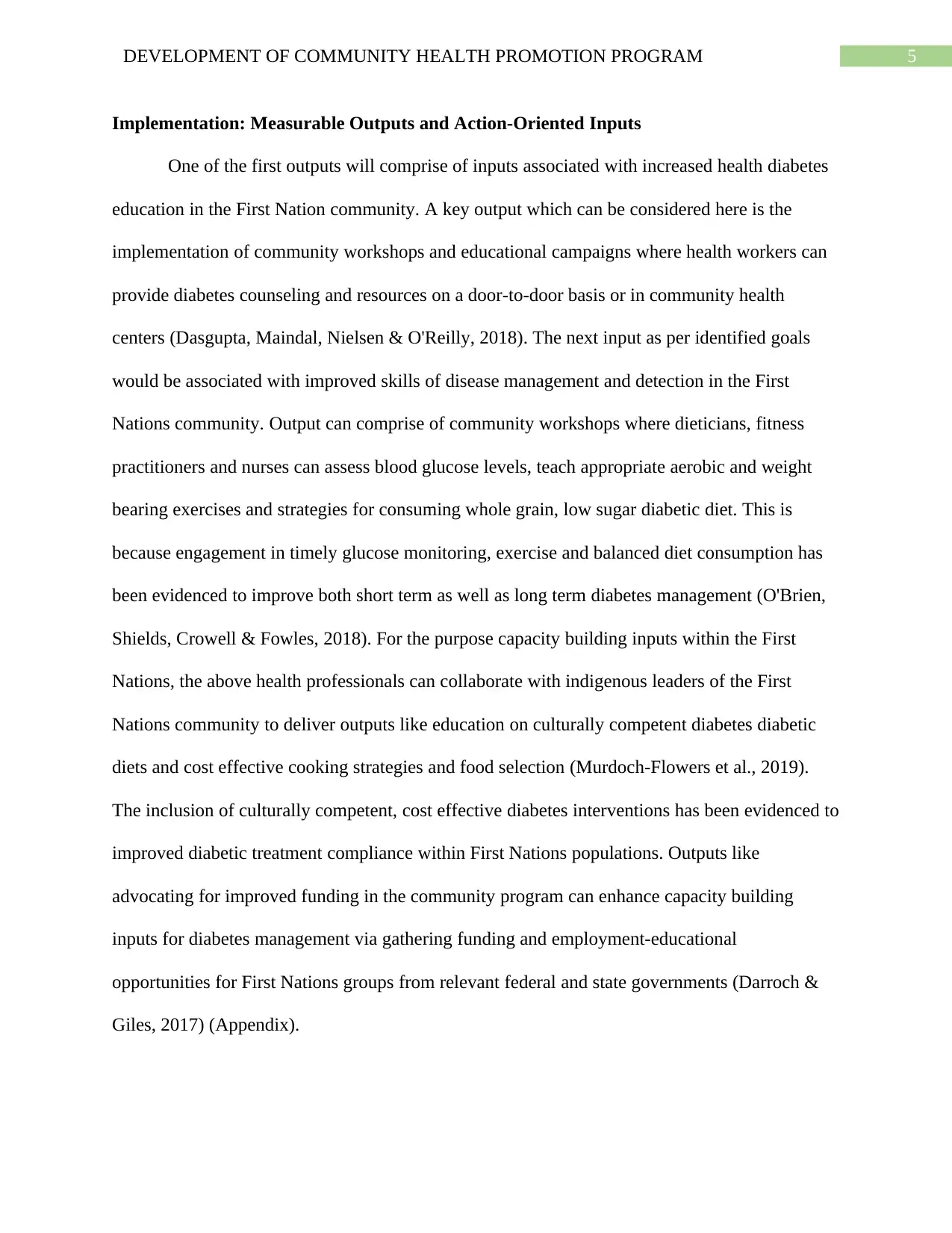
5DEVELOPMENT OF COMMUNITY HEALTH PROMOTION PROGRAM
Implementation: Measurable Outputs and Action-Oriented Inputs
One of the first outputs will comprise of inputs associated with increased health diabetes
education in the First Nation community. A key output which can be considered here is the
implementation of community workshops and educational campaigns where health workers can
provide diabetes counseling and resources on a door-to-door basis or in community health
centers (Dasgupta, Maindal, Nielsen & O'Reilly, 2018). The next input as per identified goals
would be associated with improved skills of disease management and detection in the First
Nations community. Output can comprise of community workshops where dieticians, fitness
practitioners and nurses can assess blood glucose levels, teach appropriate aerobic and weight
bearing exercises and strategies for consuming whole grain, low sugar diabetic diet. This is
because engagement in timely glucose monitoring, exercise and balanced diet consumption has
been evidenced to improve both short term as well as long term diabetes management (O'Brien,
Shields, Crowell & Fowles, 2018). For the purpose capacity building inputs within the First
Nations, the above health professionals can collaborate with indigenous leaders of the First
Nations community to deliver outputs like education on culturally competent diabetes diabetic
diets and cost effective cooking strategies and food selection (Murdoch-Flowers et al., 2019).
The inclusion of culturally competent, cost effective diabetes interventions has been evidenced to
improved diabetic treatment compliance within First Nations populations. Outputs like
advocating for improved funding in the community program can enhance capacity building
inputs for diabetes management via gathering funding and employment-educational
opportunities for First Nations groups from relevant federal and state governments (Darroch &
Giles, 2017) (Appendix).
Implementation: Measurable Outputs and Action-Oriented Inputs
One of the first outputs will comprise of inputs associated with increased health diabetes
education in the First Nation community. A key output which can be considered here is the
implementation of community workshops and educational campaigns where health workers can
provide diabetes counseling and resources on a door-to-door basis or in community health
centers (Dasgupta, Maindal, Nielsen & O'Reilly, 2018). The next input as per identified goals
would be associated with improved skills of disease management and detection in the First
Nations community. Output can comprise of community workshops where dieticians, fitness
practitioners and nurses can assess blood glucose levels, teach appropriate aerobic and weight
bearing exercises and strategies for consuming whole grain, low sugar diabetic diet. This is
because engagement in timely glucose monitoring, exercise and balanced diet consumption has
been evidenced to improve both short term as well as long term diabetes management (O'Brien,
Shields, Crowell & Fowles, 2018). For the purpose capacity building inputs within the First
Nations, the above health professionals can collaborate with indigenous leaders of the First
Nations community to deliver outputs like education on culturally competent diabetes diabetic
diets and cost effective cooking strategies and food selection (Murdoch-Flowers et al., 2019).
The inclusion of culturally competent, cost effective diabetes interventions has been evidenced to
improved diabetic treatment compliance within First Nations populations. Outputs like
advocating for improved funding in the community program can enhance capacity building
inputs for diabetes management via gathering funding and employment-educational
opportunities for First Nations groups from relevant federal and state governments (Darroch &
Giles, 2017) (Appendix).
⊘ This is a preview!⊘
Do you want full access?
Subscribe today to unlock all pages.

Trusted by 1+ million students worldwide
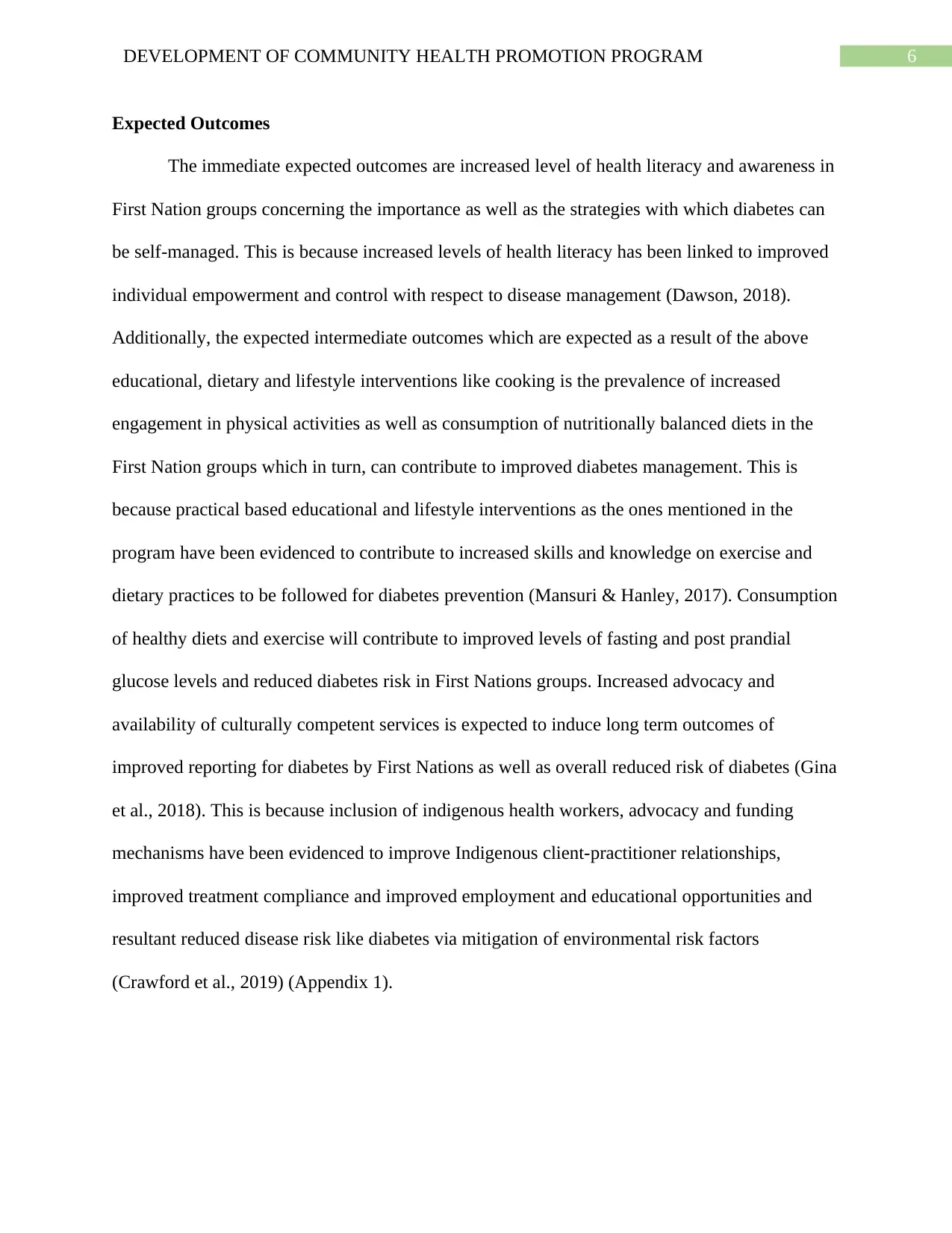
6DEVELOPMENT OF COMMUNITY HEALTH PROMOTION PROGRAM
Expected Outcomes
The immediate expected outcomes are increased level of health literacy and awareness in
First Nation groups concerning the importance as well as the strategies with which diabetes can
be self-managed. This is because increased levels of health literacy has been linked to improved
individual empowerment and control with respect to disease management (Dawson, 2018).
Additionally, the expected intermediate outcomes which are expected as a result of the above
educational, dietary and lifestyle interventions like cooking is the prevalence of increased
engagement in physical activities as well as consumption of nutritionally balanced diets in the
First Nation groups which in turn, can contribute to improved diabetes management. This is
because practical based educational and lifestyle interventions as the ones mentioned in the
program have been evidenced to contribute to increased skills and knowledge on exercise and
dietary practices to be followed for diabetes prevention (Mansuri & Hanley, 2017). Consumption
of healthy diets and exercise will contribute to improved levels of fasting and post prandial
glucose levels and reduced diabetes risk in First Nations groups. Increased advocacy and
availability of culturally competent services is expected to induce long term outcomes of
improved reporting for diabetes by First Nations as well as overall reduced risk of diabetes (Gina
et al., 2018). This is because inclusion of indigenous health workers, advocacy and funding
mechanisms have been evidenced to improve Indigenous client-practitioner relationships,
improved treatment compliance and improved employment and educational opportunities and
resultant reduced disease risk like diabetes via mitigation of environmental risk factors
(Crawford et al., 2019) (Appendix 1).
Expected Outcomes
The immediate expected outcomes are increased level of health literacy and awareness in
First Nation groups concerning the importance as well as the strategies with which diabetes can
be self-managed. This is because increased levels of health literacy has been linked to improved
individual empowerment and control with respect to disease management (Dawson, 2018).
Additionally, the expected intermediate outcomes which are expected as a result of the above
educational, dietary and lifestyle interventions like cooking is the prevalence of increased
engagement in physical activities as well as consumption of nutritionally balanced diets in the
First Nation groups which in turn, can contribute to improved diabetes management. This is
because practical based educational and lifestyle interventions as the ones mentioned in the
program have been evidenced to contribute to increased skills and knowledge on exercise and
dietary practices to be followed for diabetes prevention (Mansuri & Hanley, 2017). Consumption
of healthy diets and exercise will contribute to improved levels of fasting and post prandial
glucose levels and reduced diabetes risk in First Nations groups. Increased advocacy and
availability of culturally competent services is expected to induce long term outcomes of
improved reporting for diabetes by First Nations as well as overall reduced risk of diabetes (Gina
et al., 2018). This is because inclusion of indigenous health workers, advocacy and funding
mechanisms have been evidenced to improve Indigenous client-practitioner relationships,
improved treatment compliance and improved employment and educational opportunities and
resultant reduced disease risk like diabetes via mitigation of environmental risk factors
(Crawford et al., 2019) (Appendix 1).
Paraphrase This Document
Need a fresh take? Get an instant paraphrase of this document with our AI Paraphraser
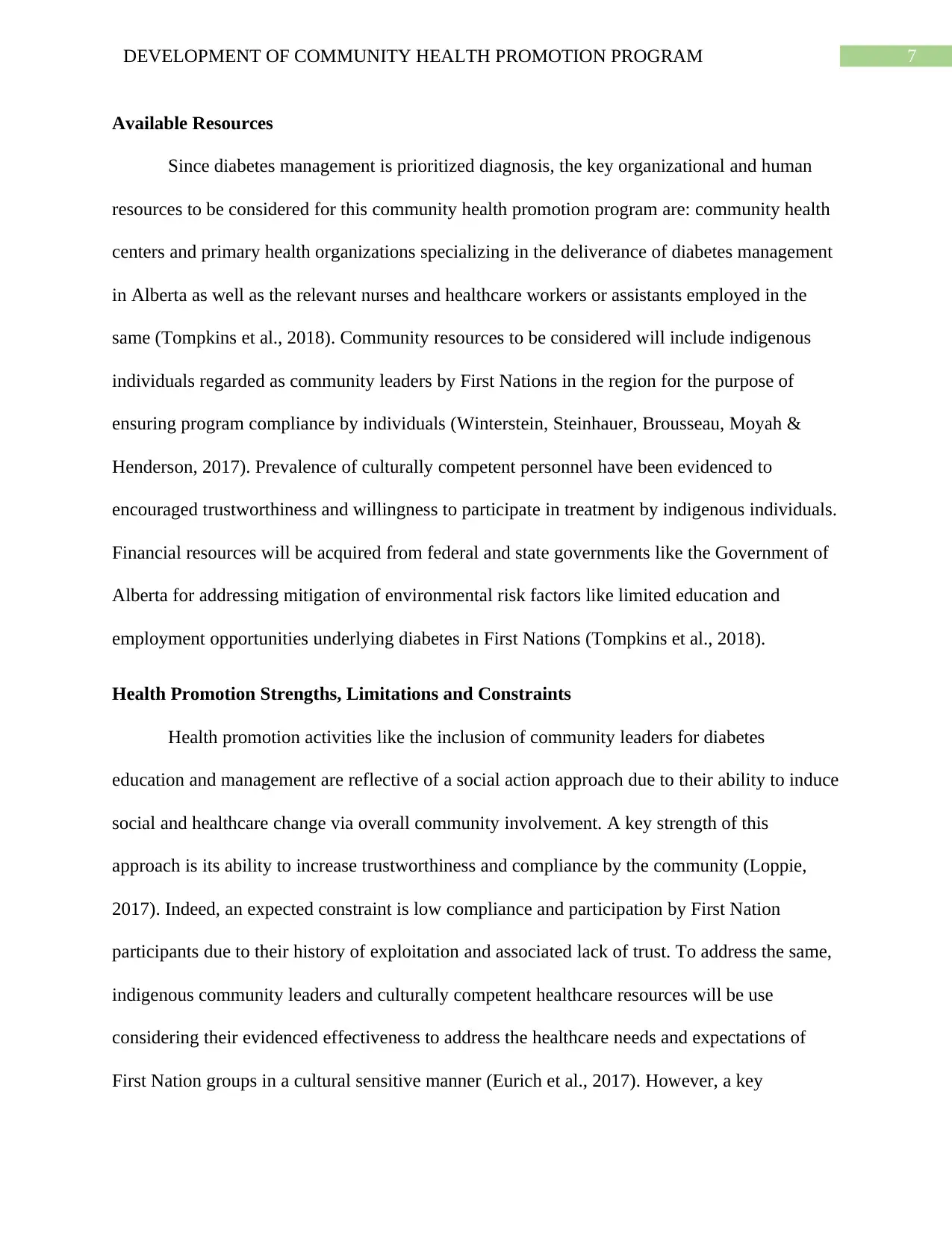
7DEVELOPMENT OF COMMUNITY HEALTH PROMOTION PROGRAM
Available Resources
Since diabetes management is prioritized diagnosis, the key organizational and human
resources to be considered for this community health promotion program are: community health
centers and primary health organizations specializing in the deliverance of diabetes management
in Alberta as well as the relevant nurses and healthcare workers or assistants employed in the
same (Tompkins et al., 2018). Community resources to be considered will include indigenous
individuals regarded as community leaders by First Nations in the region for the purpose of
ensuring program compliance by individuals (Winterstein, Steinhauer, Brousseau, Moyah &
Henderson, 2017). Prevalence of culturally competent personnel have been evidenced to
encouraged trustworthiness and willingness to participate in treatment by indigenous individuals.
Financial resources will be acquired from federal and state governments like the Government of
Alberta for addressing mitigation of environmental risk factors like limited education and
employment opportunities underlying diabetes in First Nations (Tompkins et al., 2018).
Health Promotion Strengths, Limitations and Constraints
Health promotion activities like the inclusion of community leaders for diabetes
education and management are reflective of a social action approach due to their ability to induce
social and healthcare change via overall community involvement. A key strength of this
approach is its ability to increase trustworthiness and compliance by the community (Loppie,
2017). Indeed, an expected constraint is low compliance and participation by First Nation
participants due to their history of exploitation and associated lack of trust. To address the same,
indigenous community leaders and culturally competent healthcare resources will be use
considering their evidenced effectiveness to address the healthcare needs and expectations of
First Nation groups in a cultural sensitive manner (Eurich et al., 2017). However, a key
Available Resources
Since diabetes management is prioritized diagnosis, the key organizational and human
resources to be considered for this community health promotion program are: community health
centers and primary health organizations specializing in the deliverance of diabetes management
in Alberta as well as the relevant nurses and healthcare workers or assistants employed in the
same (Tompkins et al., 2018). Community resources to be considered will include indigenous
individuals regarded as community leaders by First Nations in the region for the purpose of
ensuring program compliance by individuals (Winterstein, Steinhauer, Brousseau, Moyah &
Henderson, 2017). Prevalence of culturally competent personnel have been evidenced to
encouraged trustworthiness and willingness to participate in treatment by indigenous individuals.
Financial resources will be acquired from federal and state governments like the Government of
Alberta for addressing mitigation of environmental risk factors like limited education and
employment opportunities underlying diabetes in First Nations (Tompkins et al., 2018).
Health Promotion Strengths, Limitations and Constraints
Health promotion activities like the inclusion of community leaders for diabetes
education and management are reflective of a social action approach due to their ability to induce
social and healthcare change via overall community involvement. A key strength of this
approach is its ability to increase trustworthiness and compliance by the community (Loppie,
2017). Indeed, an expected constraint is low compliance and participation by First Nation
participants due to their history of exploitation and associated lack of trust. To address the same,
indigenous community leaders and culturally competent healthcare resources will be use
considering their evidenced effectiveness to address the healthcare needs and expectations of
First Nation groups in a cultural sensitive manner (Eurich et al., 2017). However, a key

8DEVELOPMENT OF COMMUNITY HEALTH PROMOTION PROGRAM
limitation of such social actions is the possibility that community participants may place
unrealistic expectations and consider these leaders to possess competencies to solve all their
problems. In this case, the inclusion of service extension workers like nurses, dietician and
practitioners will be beneficial due to their ability to deliver a range of specialized clinical
services (Tilahun et al., 2017). However, a key limitation of this extension worker inclusion for
this program is the lack of sufficient funding to implement the proposed interventions
considering the remote locations of residence of First Nations. The address the same funding
from state and federal governments will be considered (Hayward et al., 2020).
Community Health Nurse
Implementation of appropriate assessments is a key professional nursing responsibility
and thus, Community Health Nurses (CHNs) will be responsible for assessing fasting and post
prandial glucose levels in the First Nations individuals. Additionally, deliverance of culturally
competent healthcare education is a key professional nursing obligation and thus CHNs in this
community health program will educate indigenous groups in the diabetes community campaign
on the importance and strategies of exercise, balanced diet, health cooking and timely glucose
monitoring for improved diabetes management (Kim et al., 2016). In criticism, it must be noted
that nurses are required to practice within their scope of profession, for which collaborating with
the multidisciplinary team is of utmost importance. Thus CHNs will collaborate with dieticians
and exercise practitioners as well as Indigenous community leaders for teaching exercise,
cooking, food selection and dietary based diabetic management interventions to the First Nation
groups in the community campaigns (Trump & Mendenhall, 2017). Lastly, patient advocacy is a
key nursing obligation and thus, CHNs in collaboration with indigenous community leaders will
advocate to governmental organizations and welfare groups for greater funding, employment and
limitation of such social actions is the possibility that community participants may place
unrealistic expectations and consider these leaders to possess competencies to solve all their
problems. In this case, the inclusion of service extension workers like nurses, dietician and
practitioners will be beneficial due to their ability to deliver a range of specialized clinical
services (Tilahun et al., 2017). However, a key limitation of this extension worker inclusion for
this program is the lack of sufficient funding to implement the proposed interventions
considering the remote locations of residence of First Nations. The address the same funding
from state and federal governments will be considered (Hayward et al., 2020).
Community Health Nurse
Implementation of appropriate assessments is a key professional nursing responsibility
and thus, Community Health Nurses (CHNs) will be responsible for assessing fasting and post
prandial glucose levels in the First Nations individuals. Additionally, deliverance of culturally
competent healthcare education is a key professional nursing obligation and thus CHNs in this
community health program will educate indigenous groups in the diabetes community campaign
on the importance and strategies of exercise, balanced diet, health cooking and timely glucose
monitoring for improved diabetes management (Kim et al., 2016). In criticism, it must be noted
that nurses are required to practice within their scope of profession, for which collaborating with
the multidisciplinary team is of utmost importance. Thus CHNs will collaborate with dieticians
and exercise practitioners as well as Indigenous community leaders for teaching exercise,
cooking, food selection and dietary based diabetic management interventions to the First Nation
groups in the community campaigns (Trump & Mendenhall, 2017). Lastly, patient advocacy is a
key nursing obligation and thus, CHNs in collaboration with indigenous community leaders will
advocate to governmental organizations and welfare groups for greater funding, employment and
⊘ This is a preview!⊘
Do you want full access?
Subscribe today to unlock all pages.

Trusted by 1+ million students worldwide
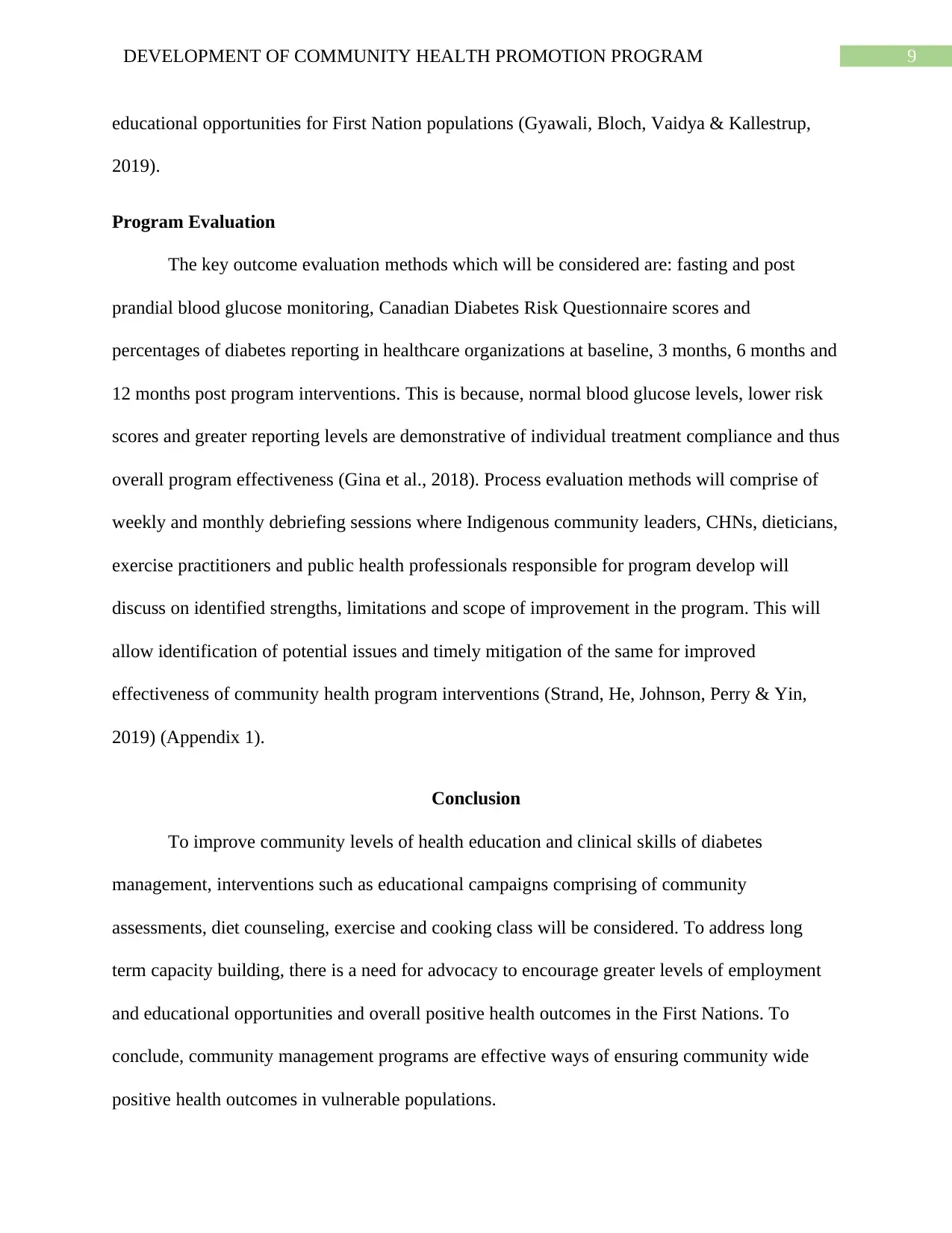
9DEVELOPMENT OF COMMUNITY HEALTH PROMOTION PROGRAM
educational opportunities for First Nation populations (Gyawali, Bloch, Vaidya & Kallestrup,
2019).
Program Evaluation
The key outcome evaluation methods which will be considered are: fasting and post
prandial blood glucose monitoring, Canadian Diabetes Risk Questionnaire scores and
percentages of diabetes reporting in healthcare organizations at baseline, 3 months, 6 months and
12 months post program interventions. This is because, normal blood glucose levels, lower risk
scores and greater reporting levels are demonstrative of individual treatment compliance and thus
overall program effectiveness (Gina et al., 2018). Process evaluation methods will comprise of
weekly and monthly debriefing sessions where Indigenous community leaders, CHNs, dieticians,
exercise practitioners and public health professionals responsible for program develop will
discuss on identified strengths, limitations and scope of improvement in the program. This will
allow identification of potential issues and timely mitigation of the same for improved
effectiveness of community health program interventions (Strand, He, Johnson, Perry & Yin,
2019) (Appendix 1).
Conclusion
To improve community levels of health education and clinical skills of diabetes
management, interventions such as educational campaigns comprising of community
assessments, diet counseling, exercise and cooking class will be considered. To address long
term capacity building, there is a need for advocacy to encourage greater levels of employment
and educational opportunities and overall positive health outcomes in the First Nations. To
conclude, community management programs are effective ways of ensuring community wide
positive health outcomes in vulnerable populations.
educational opportunities for First Nation populations (Gyawali, Bloch, Vaidya & Kallestrup,
2019).
Program Evaluation
The key outcome evaluation methods which will be considered are: fasting and post
prandial blood glucose monitoring, Canadian Diabetes Risk Questionnaire scores and
percentages of diabetes reporting in healthcare organizations at baseline, 3 months, 6 months and
12 months post program interventions. This is because, normal blood glucose levels, lower risk
scores and greater reporting levels are demonstrative of individual treatment compliance and thus
overall program effectiveness (Gina et al., 2018). Process evaluation methods will comprise of
weekly and monthly debriefing sessions where Indigenous community leaders, CHNs, dieticians,
exercise practitioners and public health professionals responsible for program develop will
discuss on identified strengths, limitations and scope of improvement in the program. This will
allow identification of potential issues and timely mitigation of the same for improved
effectiveness of community health program interventions (Strand, He, Johnson, Perry & Yin,
2019) (Appendix 1).
Conclusion
To improve community levels of health education and clinical skills of diabetes
management, interventions such as educational campaigns comprising of community
assessments, diet counseling, exercise and cooking class will be considered. To address long
term capacity building, there is a need for advocacy to encourage greater levels of employment
and educational opportunities and overall positive health outcomes in the First Nations. To
conclude, community management programs are effective ways of ensuring community wide
positive health outcomes in vulnerable populations.
Paraphrase This Document
Need a fresh take? Get an instant paraphrase of this document with our AI Paraphraser
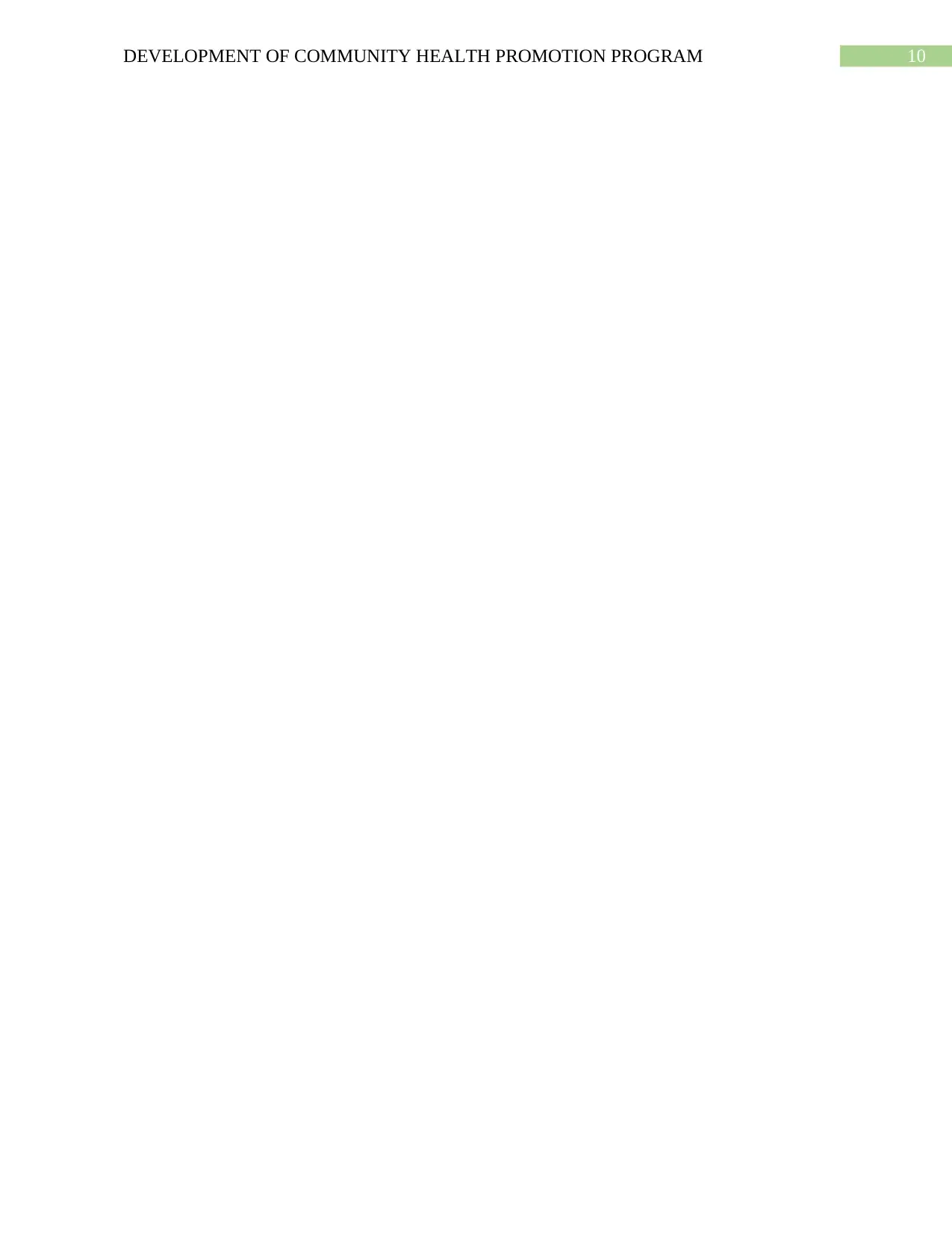
10DEVELOPMENT OF COMMUNITY HEALTH PROMOTION PROGRAM
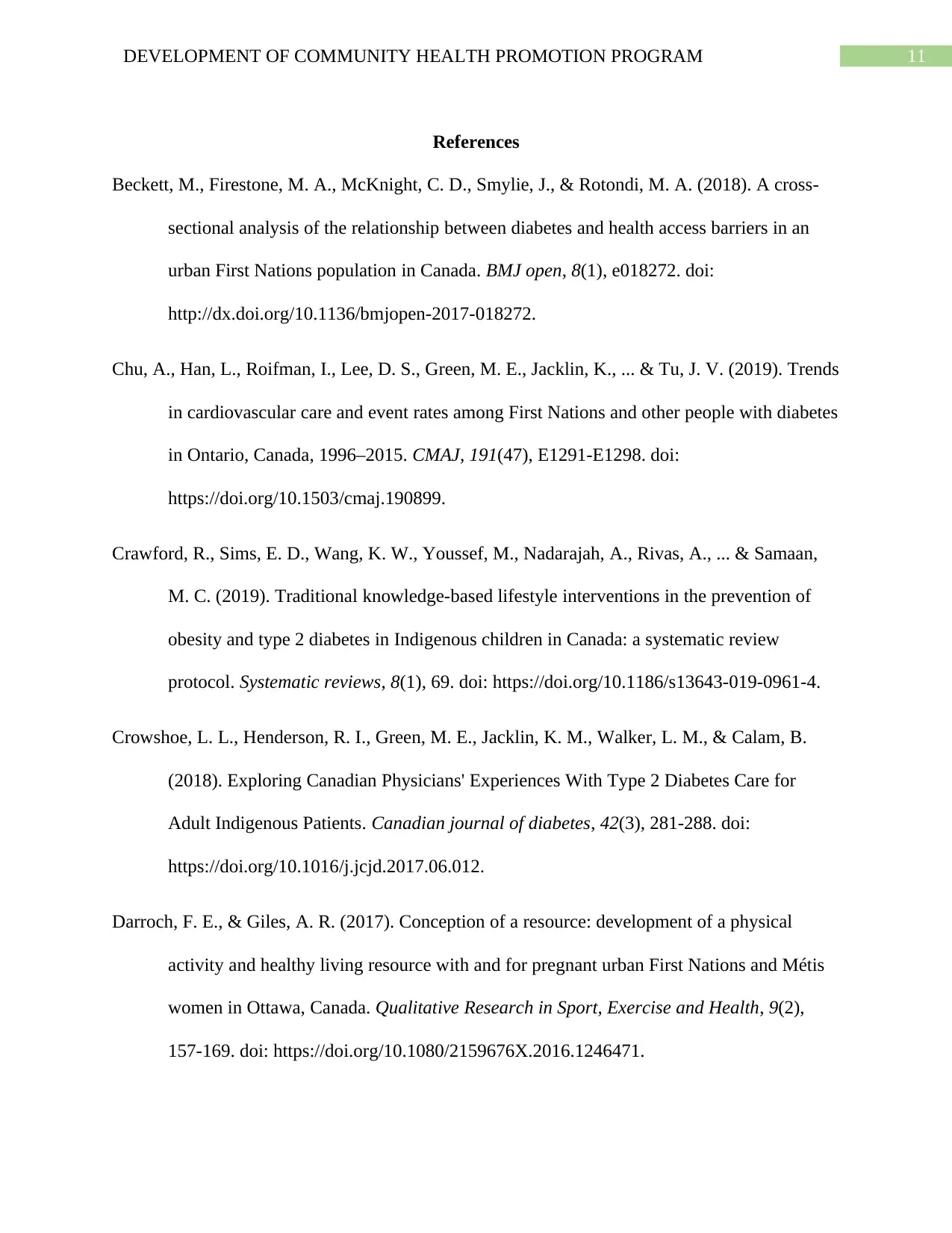
11DEVELOPMENT OF COMMUNITY HEALTH PROMOTION PROGRAM
References
Beckett, M., Firestone, M. A., McKnight, C. D., Smylie, J., & Rotondi, M. A. (2018). A cross-
sectional analysis of the relationship between diabetes and health access barriers in an
urban First Nations population in Canada. BMJ open, 8(1), e018272. doi:
http://dx.doi.org/10.1136/bmjopen-2017-018272.
Chu, A., Han, L., Roifman, I., Lee, D. S., Green, M. E., Jacklin, K., ... & Tu, J. V. (2019). Trends
in cardiovascular care and event rates among First Nations and other people with diabetes
in Ontario, Canada, 1996–2015. CMAJ, 191(47), E1291-E1298. doi:
https://doi.org/10.1503/cmaj.190899.
Crawford, R., Sims, E. D., Wang, K. W., Youssef, M., Nadarajah, A., Rivas, A., ... & Samaan,
M. C. (2019). Traditional knowledge-based lifestyle interventions in the prevention of
obesity and type 2 diabetes in Indigenous children in Canada: a systematic review
protocol. Systematic reviews, 8(1), 69. doi: https://doi.org/10.1186/s13643-019-0961-4.
Crowshoe, L. L., Henderson, R. I., Green, M. E., Jacklin, K. M., Walker, L. M., & Calam, B.
(2018). Exploring Canadian Physicians' Experiences With Type 2 Diabetes Care for
Adult Indigenous Patients. Canadian journal of diabetes, 42(3), 281-288. doi:
https://doi.org/10.1016/j.jcjd.2017.06.012.
Darroch, F. E., & Giles, A. R. (2017). Conception of a resource: development of a physical
activity and healthy living resource with and for pregnant urban First Nations and Métis
women in Ottawa, Canada. Qualitative Research in Sport, Exercise and Health, 9(2),
157-169. doi: https://doi.org/10.1080/2159676X.2016.1246471.
References
Beckett, M., Firestone, M. A., McKnight, C. D., Smylie, J., & Rotondi, M. A. (2018). A cross-
sectional analysis of the relationship between diabetes and health access barriers in an
urban First Nations population in Canada. BMJ open, 8(1), e018272. doi:
http://dx.doi.org/10.1136/bmjopen-2017-018272.
Chu, A., Han, L., Roifman, I., Lee, D. S., Green, M. E., Jacklin, K., ... & Tu, J. V. (2019). Trends
in cardiovascular care and event rates among First Nations and other people with diabetes
in Ontario, Canada, 1996–2015. CMAJ, 191(47), E1291-E1298. doi:
https://doi.org/10.1503/cmaj.190899.
Crawford, R., Sims, E. D., Wang, K. W., Youssef, M., Nadarajah, A., Rivas, A., ... & Samaan,
M. C. (2019). Traditional knowledge-based lifestyle interventions in the prevention of
obesity and type 2 diabetes in Indigenous children in Canada: a systematic review
protocol. Systematic reviews, 8(1), 69. doi: https://doi.org/10.1186/s13643-019-0961-4.
Crowshoe, L. L., Henderson, R. I., Green, M. E., Jacklin, K. M., Walker, L. M., & Calam, B.
(2018). Exploring Canadian Physicians' Experiences With Type 2 Diabetes Care for
Adult Indigenous Patients. Canadian journal of diabetes, 42(3), 281-288. doi:
https://doi.org/10.1016/j.jcjd.2017.06.012.
Darroch, F. E., & Giles, A. R. (2017). Conception of a resource: development of a physical
activity and healthy living resource with and for pregnant urban First Nations and Métis
women in Ottawa, Canada. Qualitative Research in Sport, Exercise and Health, 9(2),
157-169. doi: https://doi.org/10.1080/2159676X.2016.1246471.
⊘ This is a preview!⊘
Do you want full access?
Subscribe today to unlock all pages.

Trusted by 1+ million students worldwide
1 out of 19
Related Documents
Your All-in-One AI-Powered Toolkit for Academic Success.
+13062052269
info@desklib.com
Available 24*7 on WhatsApp / Email
![[object Object]](/_next/static/media/star-bottom.7253800d.svg)
Unlock your academic potential
Copyright © 2020–2025 A2Z Services. All Rights Reserved. Developed and managed by ZUCOL.





